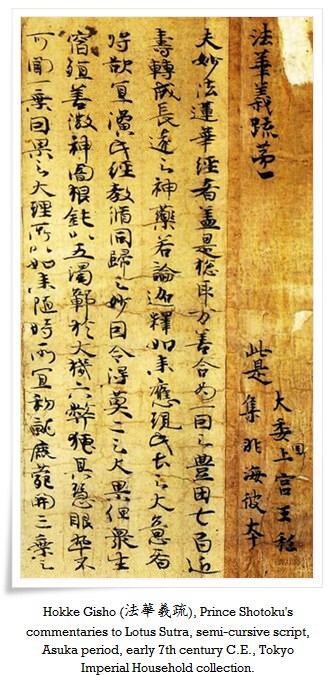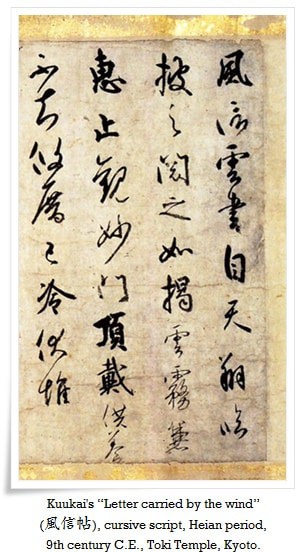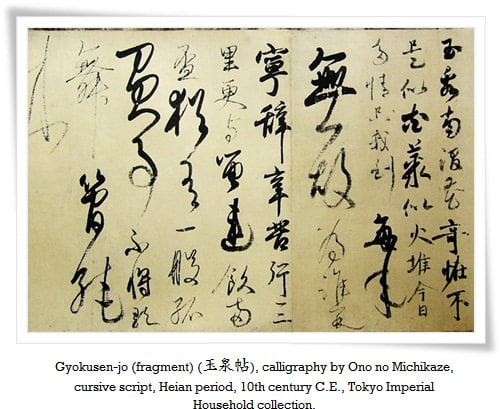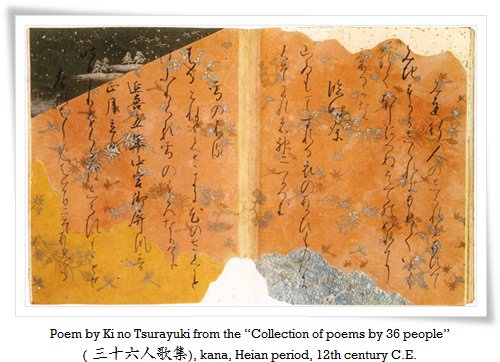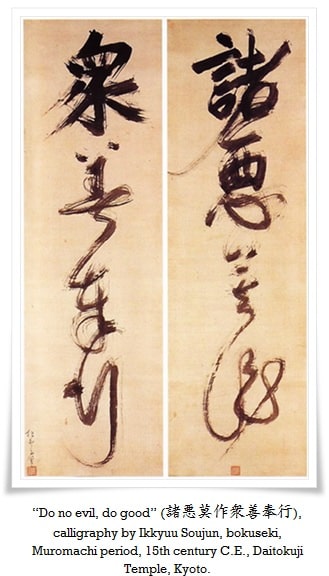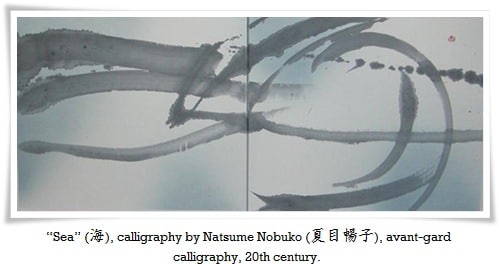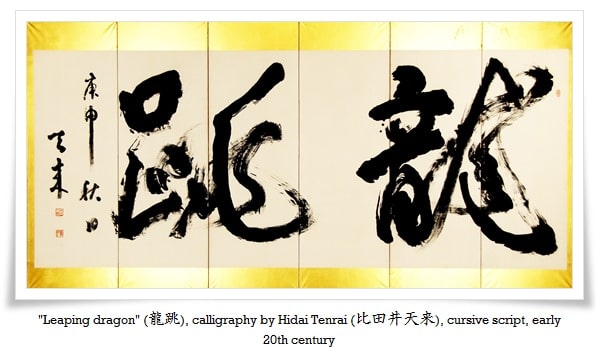The history of Japanese calligraphy begins with importing the Chinese writing system, namely kanji (漢字, which in Japanese means “characters of Han China”), in the early 5th century C.E., although Chinese characters were first appearing in Japan on various items brought from China starting with the beginning of the 1st century C.E.
At that point, the Chinese writing system was fully matured and developed. There were approximately 50 000 kanji in circulation, 5 major styles of calligraphy and numerous sub-styles.
Since Japanese linguistics and grammar are quite different from Chinese, the necessity of fitting a writing system to a completely new language raised a serious practical problem. Nonetheless, it has led to creating unique calligraphy styles that are exclusively used in Japan, such as Kana (かな).
During the Asuka (飛鳥時代, 538 – 710 C.E., although dates may vary based on different historical events being considered) and Nara (奈良時代, 710-794 C.E.) periods, copying Buddhist sutras was already a very popular practice, which greatly contributed to strengthening the appreciation and fascination with Chinese culture. At that time Japanese calligraphy was especially influenced by writing styles developed during Chinese Jin (晉朝, 265 – 420 C.E.) and Tang (唐朝, 618 – 907 C.E.) dynasties. This general trend was called karayou (唐様, lit. Tang style), which means “Chinese style”.
One of the great admirers of Buddhist teachings was the Japanese prince Shotoku Taishi (聖徳太子,, 574–622), who promoted its philosophy, and also built several major temples. He was the one who strengthened the popularity of shakyou (写経, hand copying of sutras), that further led to the development of calligraphy in Japan.
At this point, Japanese sho (calligraphy) was still deeply influenced by Chinese masters like Wang Xizhi (王儀之, 303 – 361). A vast amount of works were based on his style, all the way until Heian period (平安時代, 794 – 1185 C.E.)
The 10th century was a time of significant change in Japanese calligraphy. It is when Ono No Michikaze (小野道風 894–966, who is also known as Ono no Toufuu) introduced a fresh approach and the first truly Japanese style, called wayoushodou (和様書道, lit. “Japanese style calligraphy”). This trend however, was originally brought into being earlier on by the famous Buddhist monk and outstanding calligrapher Kukai (空海, 774- 835), who gained the sacred Buddhist name “the great (Buddhist) teacher” (弘法大師, Koubou Daishi). At this point it became acceptable for Japanese literature and calligraphy to finally deviate from Chinese aesthetics.
Ono no Toufuu, was considered one of the 10th century sanseki (三蹟, lit. “three brush traces”), along with two other individuals Fujiwara no Sukemasa (藤原佐理, 944 – 998) and Fujiwara no Yukinari (藤原行成, 972 – 1027).
Michikaze was so talented, that he was accepted to serve at the imperial quarters at the age of 27. He was a diligent calligrapher and his style was naturally powerful yet easy for the soul to appreciate. The other two of the sanseki, greatly contributed to developing further what Michikaze started.
A good example of work that not only displays Michikaze’s potential and artistic capacity but also how versatile his style was, is Gyokusen Jou (玉泉帖), a kansubon (巻子本, lit. “a rolled book”) with poems that were composed during Tang dynasty (唐朝, 618 – 907) in China. It is also a great masterpiece of wayoushodou, full of surprising rhythm, extremes in proportional scaling, wide variety of line strength, slow brush traces suddenly rushing through paper, mocking the changes of the emotional states of the artist.
Wayoushodou was based on sougana (草仮名, cursive kana) and Kana (かな, calligraphy script), which derive from manyougana (万葉仮名, “kana of ten thousand leaves”). It was a result of pursuing aesthetics native to Japan, by members of the upper class.
Manyougana was a remedy for grammatical differences between Chinese and Japanese languages which this new writing system had to face. Manyougana was then applied as grammatical fillings, postfixes, particles, etc. It was nothing else than kanji used purely for phonetic reasons.
Imagine how difficult it must have been to read texts with some kanji playing semantic roles and others reflecting only sounds (though they bore their own abstract meanings anyway, like any other Chinese characters). Around the 12th century there were approximately 1000 kanji in use as manyougana.
Sougana is nothing else but manyougana in Cursive script, thus in sousho (草書). Simplified sougana gave birth to modern hiragana (平仮名) which is used in a unique Japanese calligraphy script – Kana.
Today, the Japanese language has three writing systems: kanji, hiragana and katakana (片仮名). Both katakana and hiragana are syllabaries, not alphabets, as they carry no semantic meanings. Hiragana is based on simplified cursive forms of kanji (simplified sousho), and katakana on kanji compounds in their standard form. Hiragana has replaced troublesome manyougana with much simpler and fewer forms, although both writing systems are still used (together) in the highly artistic art of Japanese calligraphy, namely kana.
During the Kamakura period (鎌倉時代, 1185–1333), the art of writing is further strongly influenced by the philosophy of Buddhism, and especially Zen Buddhism. The first school of Zen Buddhism on Japanese soil was Rinsai (臨剤) founded in the 12th century, and it still exists till today throughout Japan in its numerous branches. Its influence over the military and culture was remarkable, and also extended to calligraphy.
Zen calligraphy is called bokuseki (墨蹟, lit. “traces of ink”) and it is rather liberal in form and follows extremely loose rules, if any at all. In fact it is not for the rules to decide the final shape of the characters and definition of space. Zen monks (usually) are not professional calligraphers, at least not all of them, thus their writing is unrestrained. Zen calligraphy is to be written with the entire body, while standing, by engaging “void mind” and pure emotion, through visualizing whatever the subject of the given calligraphy is.
Zen sho is extremely abstract and because of its deviation from strict rules it is also rather difficult for the orthodox calligraphers to fully appreciate it. Nonetheless it is fascinating and very spiritual. Modern calligraphy of the 20th century, that draws heavily from western abstract schools of painting, is somewhat related in its appearance and general concept to bokuseki. One of the differences is that bokuseki is based on karayoushodou (Chinese calligraphy styles) while avant-garde sho draws heavily from wayoushodou aesthetics.
Until the Edo period (江戸時代, 1603-1868) both schools; wayoushodou and karayoushodou coexisted quite harmoniously, but in the early 17th century Japan enters a long period of cultural isolation. During those years a new style based on wayoushodou was created, known as oie ryuu (御家流, lit. “noble family style”). It was also called the “samurai family style”, and was pursued in famous Terakoya school (寺子屋), offering education to children born to middle class families. Reading and writing were the main, although not the only, subjects taught. Students learned by imitating teachers writing, presented to them on tehon (手本, a copy book). This is a method still followed in Japan today in regards to novices.
During the Edo period peculiar group of styles of written characters came to life, called edo moji (江戸文字, lit. “characters from Edo period”). They were mainly used for designing purposes, writing names of sumo wrestlers, store banners, etc. Today, calligraphers consider them more of a craft (in this understanding they are closer to western calligraphy) than art, having little to nothing in common with the traditional way of writing Chinese characters.
The end of the Edo period put an end to the isolation of Japan, and calligraphers widely appreciated karayou styles once again. Studying basics, such as kaisho, gyousho and sousho, but also other ancient and formative styles like reisho, tensho or even koukotsubun become rather popular in professional calligraphic circles.
Today, with instant information access, cultural exchange has ascended to a completely new level. Far Eastern calligraphy was profoundly influenced by modern abstract painting, and vice versa. Consequently, a style called “image of ink” (墨象, bokushou) was developed in Japan. It is a crossover between calligraphy, sumi-e and modern abstract art. It is also referred to as avant-garde calligraphy. The forefather of “image of ink” was grand master calligrapher Hidai Ternai (比田井天来 1872 – 1939).
Further, designers with calligraphic background contributed to creating a POP “style”, being quite often on the verge of breaking strict laws of calligraphy (or simply breaking them). With that, logos and other imaginative compositions, based on logographic ideas and somewhat linked to Chinese characters, were offered a total makeover. Many old-school calligraphers see it as a dangerous practice, possibly leading to relaxing rules of sho and therefore diluting its essential beauty, similar to what simplifying Chinese characters does to the writing systems based on kanji. Still, since this POP “style” is deeply rooted in Far Eastern aesthetics it may seem very intriguing even for the most rigid calligrapher. Nonetheless, one needs to be cautious with modern approaches and such “styles” of calligraphy in a very broad sense, as the border between sho and just a random maze of lines may be quite difficult to draw, especially for the layman.

